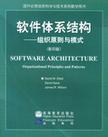软件体系结构(影印版)
2002-10
(影印版) (2002年1月1日)
Dikel
281
460000
本书着重阐述软件体系结构和组织机构之间的关系,书中内容基于长达数年的对一些著名大型软件开发机构的研究,并介绍产品线和所实现的中、小型和大型组织的体系结构。研究成果产生了包括五种影响软件体系结构成败的组织原则的VRAPS模型:视觉效果,节奏,预见性,合作性和简化性。本书由综述引申到案例研究,说明按照VRAPS原则,企业如何从小规模启动成长为构建因特网应用工具的领先企业,并提供一定的尺度帮助读者衡量自身机构运用此原则的深度。书末章节提供如何使用模型的现实世界描述,配有九个特殊样板、工具和指导,描述模式如何用于一种商业标准,使读者能利用它来评估自身组织机构并使之与其他机构相比较。本书适用于计算机科学中的软件工程等课程。
作者David M. Dikel是SRA国际公司专家组资深专家,David Kane是该公司技术小组主任,James R. Wilson是Cyberserv公司首席技术官。均从事软件开发和软件体系结构研究多年,有着丰富的经验。
PrefaceAcknowledgmentsCredits1 What You Can't See Could Help You What This Book is About Software Architecture's Growing Importance For Some, the News They are Stakeholders Comes Too Late Prineiple Reveal the Hidden Vision Rhythm Anticipation Partnering Simplification Taking Action With Principles Organizational Principles at Work: The Architect's New Job Rhythm vision Simplification and Anticipation Partnering Principles on the Web Summary2 The VRAPS Reference Model: How the Pieces Fit Together Overview Why Models are Important The VRAPS Model Context Organizational Principles for Software Arehitecture The Role of Principles Vision Rhythm Anticipation Partnering Simplification Principles Interact Conceptual Framework Criteria Patterns Antipatterns Applying the VRAPS Model VRAPS Evolution Summary3 Projecting and Unifying Vision Overview Vision Definition Mapping Value to Architectural Constraints Congruence and Flexibility Vision Challenges Limits of Archirect Influence Executive and Architect Cooperation Product Lines Increase the Challenges to Architects and Execudves Recognizing Breakdown Shaping a Vision Will the Real Architect Please Stand Up? Vision and Leadership No Respect Putting Vision Into Practice: Criteria, Antipatterns, and Patterns Criterion 1: The architect's vision aligns with what his or her sponsors, users, and end customers are frying to accomplish ANTIGRAVITY MODULE FRONT-END ALlGNMENT Criterion 2: Practitioners frust and use the architecture TRENn SURFER GENERAUYE VISION Criterion 3: Tacit Knowledge about architecture and components is visi- ble and accessible to users FOLLOWIMG ORDERS ROTATION Summary Other Applicable Patterns and Antipatterns4 Rhythm: Assuring Beat, Process, and Movement Overview Tempo Content Quality Rhythm Definition Motivation Rhythm Aids Transition Management Rhythm Drives Closure Putting Rhythm Into Praetice: Criteria, Antipatterns, and Patterns Criterion 1 : Managers pedodically reevaluate, synchronize, and adapt the architecture KILLER FEATURE RELEASE COMMITTEE Criterion 21:Architecture users have a high level of confidence in the timing and content of architecture releases SHORTUT DROP PAss Criterion 3: Explicit activities are coordinated via rhythm BROKEN LOADS SYNCHRONIZE RELEASES Summary Other Applicable Patterns and Antipatterns5 Anticipation : Predieting, Validating, and Adapting Overview Prediction Validation Adaptation Anticipation Definition Anticipation in Action Pulling Architectures in Many Directions The Architecture Customers and Their Customers Aiming Too Far Info the Future Aiming Too Close to the Present Balancing rhe Needs of Today and the Future Striking a Balance Putting Anticpation taka Practice: Criteria, Antipatterns, and Patterns Criterion 1 : Architecture capability is regularly enhanced to respond to anticipated risks and requirements of architecture customers and their customers, market-driving standards and evolving technology, and changes in strategic business directions MlSSING PIECE PILOT Criterion 2: Technical and business risks and opporunities are evaluat-ed through a quick quick of revlew and development BLEEDING EDGE ARCHITECTURE REVIEW Criterion 3: Features, budgets, plans, or schedules are adapted when it is recognized that critical estimates or assumptions are incorrect TUNNEL VISION OUTSOURCE Summary Other Applieable Patterns and Antipatterns6 Partnering: Building Cooperative Organizations Overview Cooperative Relationships Partnering Definition Architecture Stakeholders Clear, Cooperative Roles Maximizing Value Industrial Roots Contract Management Networked Organizations Value Chain Trust Putting Partnering Into Practice: Criteria Antipatterns, and Patterns Criterion 1 :The architect continually seeks to understand who the most criti-cal stakeholders are, how they contribute value, and what they want PHONE DOESN'T RING KNOW THY STAKEHOLDERS Criterionn 2: Clear compelling agreements exist between stakeholders LIP-SYNCHING RECIPROCITY Criterion 3: Both policies and informal rules of social conduct enforce cooperation PERSONAL TIME No SURPRSES PROMOTE THE NETWORK Summary Other Applicable Patterns and Antipatterns7 Simplification: Clarfying and Mi8 Principles at Work: The Allaire Case Study9 Case Study: Building and Implementing a BenchmarkA Quick Reference Table: Principles, Criteria,Antipatterns, and PatternsB Antipattern and Pattern SummariesReferencesIndex
